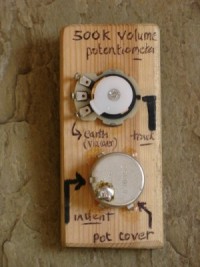
The electrics on most passive (non-active) instruments are really simple. Basically all that happens is a signal goes in one side of a potentiometer (pot) and comes out the other, via a wiper tag connected to a control knob.
On a typical volume pot the wiper conducts the signal from the pick-up, either towards the output jack socket or to earth tag of the pot. The pot casings, both volume and tone are all linked by a wire which is connected via a common earth to the jack socket.
The tone pot is slightly different. Instead of the signal going straight to earth it passes through a capacitor which “bleeds off” the treble frequencies from the overall sound. Again the wiper controls the amount of signal affected by its proximity to either the capacitor or the direct connection between the tone and volume pot.
Different guitars utilise different types of switches. Fender-type guitars tend to have three-way or five-way sliding switches. Gibson-type instruments generally utilise the make or break toggle switches. Each have their pros and cons but essentially provide a metal to metal contact through which the electrical signal can pass.
Over a period of time air-borne moisture can cause corrosion within these electrical components. It’s worthwhile to give them all a spray with a dedicated switch cleaner now and again to keep things sweet. However, don’t use WD-40 type sprays they’re much too oily and attract all the dust of the day which cruds up the internals of the pots and switches.
The jack socket is always the last stage in the chain between the input and output. Like the other components, these vary in quality and it’s worth being aware of the different grades you will encounter. The best are made by Switchcraft and are heavy duty items which will withstand a lot of abuse. I would recommend fitting them in preference to anything else.
To carry out any electrical repair you will require a soldering iron. A general purpose one, rated around 25 watts sounds about right. Keep the tip clean and carefully store it when not in use. Always make sure you “tin” the tip before it sees any action.
Remember soldering irons burn and their burns are particularly nasty.